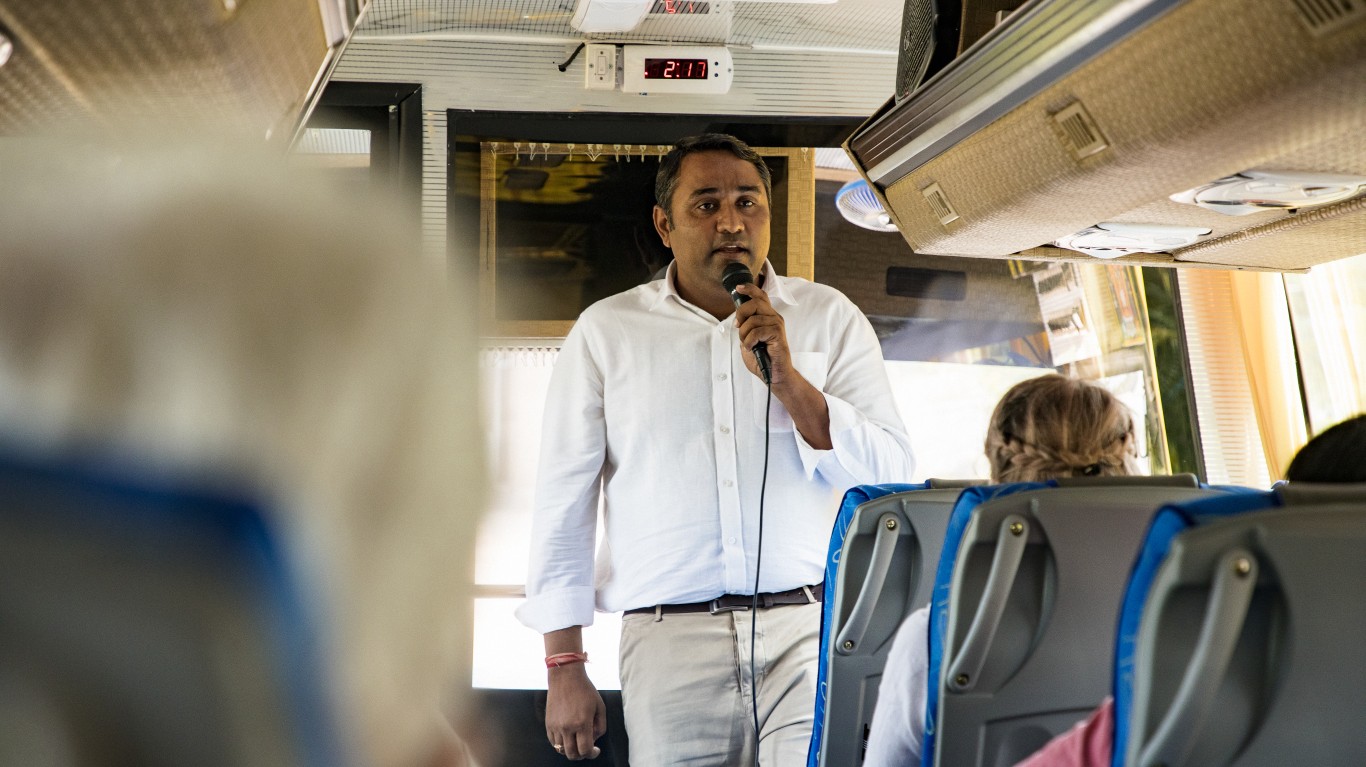
The COVID-19 pandemic was a historically major shock to the U.S. economy, accelerating market trends by several years and adding an unprecedented level of uncertainty to the global business environment. Still, many industries have thrived in the new economy, offering many opportunities to entrepreneurs. Opportunities in other industries, however, shrank due to economic trends of the last several years. Some of them are among America’s 25 dying industries.
To determine the worst business ideas in America, 24/7 Wall St. identified the fastest shrinking small business industries using data from the U.S. Census Bureau’s County Business Patterns program. Detailed industries were ranked based on the percentage change in establishments from 2017 to 2021. Only industries in which the average establishment size is less than 20 employees were considered.
Many of the fastest shrinking small business opportunities are in industries being hammered by the decades-long shift from print to digital media. From 2018 to 2022, the average amount of time adults spent consuming digital media rose from 6.3 to 8 hours, while engagement with traditional media fell from 6 to 5.3 hours. As a result, businesses like video rental, one-hour photofinishing, and newsstands continued to decline. Companies in these industries will likely not make the list of youngest companies in the Fortune 500.
Other small businesses have suffered from the shift to e-commerce from traditional brick-and-mortar stores. The dominance of online retailers like Amazon continues to drive independent clothing stores, shoe stores, and appliance stores out of business. The number of children’s and infants’ clothing stores fell by 41.3% from 2017 to 2021, the third most of any small business industry.
Click here to see the worst business ideas in America.
Click here to see our detailed methodology.

20. Stationery and Office Supplies Merchant Wholesalers
> Establishment decline, 2017 to 2021: -20.1%
> Total establishments, 2021: 3,546
> Total employees, 2021: 60,442
> Avg. annual pay, 2021: $52,160
The increasing digitalization of offices and businesses has led to a reduced demand for traditional stationery and office supplies. With the shift towards digital documents, cloud storage, and electronic communication, the need for physical paper, pens, and other office supplies has decreased. Over the past few years, the number of businesses in the industry fell 20.1% from 4,439 in 2017 to 3,546 in 2021.
One other factor behind decline in the industry may be remote work and telecommuting, which further impacted the demand for stationery and office supplies. With employees working from home or off-site, the demand for traditional office supplies used in physical office spaces has declined.
[in-text-ad]

19. Office Supplies and Stationery Stores
> Establishment decline, 2017 to 2021: -21.2%
> Total establishments, 2021: 4,475
> Total employees, 2021: 48,612
> Avg. annual pay, 2021: $24,925
Just like the office supply wholesalers, office supply retailers have been similarly impacted by the increasing digitalization of offices and businesses, which has reduced the need for traditional stationery and office supplies. With the shift towards digital documents, cloud storage, and electronic communication, the demand for physical paper, pens, and other stationery items has declined. The number of businesses in the industry fell 21.2% from 5,678 in 2017 to 4,475 in 2021.
One other factor behind decline in the industry may be remote work and telecommuting. The rise of remote work and telecommuting has further impacted the demand for office supplies. With employees working from home or off-site, the need for traditional office supplies used in physical office spaces has decreased.

18. Direct Mail Advertising
> Establishment decline, 2017 to 2021: -21.7%
> Total establishments, 2021: 1,963
> Total employees, 2021: 35,421
> Avg. annual pay, 2021: $64,388
The increasing popularity of digital advertising channels, such as social media marketing, search engine advertising, and email marketing, has led to a decline in the demand for direct mail advertising. Digital advertising offers greater targeting capabilities, real-time tracking, and cost efficiencies compared to traditional direct mail campaigns. The number of businesses in the industry fell 21.7% from 2,508 in 2017 to 1,963 in 2021, among the fastest contractions of any industry.
One other factor behind decline in the industry may be changing consumer preferences. Consumer behavior has shifted towards digital media consumption, with more individuals relying on online platforms for information and entertainment. This shift has reduced the effectiveness and relevance of direct mail as a marketing tool, as consumers increasingly prefer digital communication channels.
17. News Dealers and Newsstands
> Establishment decline, 2017 to 2021: -21.8%
> Total establishments, 2021: 771
> Total employees, 2021: 2,413
> Avg. annual pay, 2021: $25,219
The growing popularity of online news platforms and digital content consumption has significantly impacted the demand for physical newspapers and magazines. Consumers increasingly rely on digital sources for news and information, reducing their reliance on traditional news dealers and newsstands. The number of businesses in the industry fell 21.8% from 986 in 2017 to 771 in 2021.
One other factor behind decline in the industry may be changing consumer preferences. The convenience of accessing news online, including personalized news feeds, real-time updates, and a wide range of digital content, has altered consumer preferences. The demand for physical newspapers and magazines has declined as consumers opt for more flexible and easily accessible digital alternatives.
[in-text-ad-2]

16. Scenic and Sightseeing Transportation, Other
> Establishment decline, 2017 to 2021: -22.2%
> Total establishments, 2021: 267
> Total employees, 2021: 2,115
> Avg. annual pay, 2021: $58,854
The outbreak of the COVID-19 pandemic severely impacted the travel and tourism industry, including scenic and sightseeing transportation. Travel restrictions, lockdown measures, and reduced travel demand resulted in a significant decline in tourist activities and sightseeing tours during the pandemic. The number of businesses in the industry fell 22.2% from 343 in 2017 to 267 in 2021.
Another factor behind decline in the industry may be operational challenges during the pandemic. Social distancing requirements, capacity restrictions, and health and safety protocols limited the number of passengers and the viability of running tours. Some operators had to suspend or reduce their services, leading to a decline in the number of establishments.

15. New Housing For-Sale Builders
> Establishment decline, 2017 to 2021: -22.4%
> Total establishments, 2021: 12,535
> Total employees, 2021: 122,057
> Avg. annual pay, 2021: $107,873
The COVID-19 pandemic created significant uncertainty in the housing market. Fluctuations in home prices, interest rates, and buyer preferences made it difficult for spec home builders to accurately assess market demand and set competitive prices. This uncertainty could have resulted in spec homes remaining unsold, leading to financial losses for builders. The number of businesses in the industry fell 22.4% from 16,152 in 2017 to 12,535 in 2021.
Another factor behind decline in the industry may be construction labor shortages. The availability of skilled construction labor can impact the supply of new housing. Labor shortages in the construction industry, including shortages of skilled workers such as carpenters, electricians, and plumbers, may have limited the capacity of builders to construct new homes and contributed to the decline in establishments.
[in-text-ad]

14. Support Activities for Printing
> Establishment decline, 2017 to 2021: -23.0%
> Total establishments, 2021: 1,059
> Total employees, 2021: 17,620
> Avg. annual pay, 2021: $53,079
The shift from traditional printed materials to digital media has significantly impacted the demand for printing services. With the rise of digital platforms and online content consumption, businesses and individuals have increasingly relied on electronic formats for advertising, publishing, and communication. This trend has reduced the demand for traditional printing services, leading to a decline in establishments in the support activities for the printing industry. The number of businesses in the industry fell 23.0% from 1,375 in 2017 to 1,059 in 2021, among the fastest contractions of any industry.
Additionally, the printing industry has experienced rapid technological advancements, such as digital printing, automation, and improved production efficiencies. These advancements have led to increased productivity and reduced the need for manual labor and support activities. As a result, establishments in the support activities for the printing industry may have experienced consolidation or closures due to the improved efficiency of printing processes.

13. Formal Wear and Costume Rental
> Establishment decline, 2017 to 2021: -23.2%
> Total establishments, 2021: 726
> Total employees, 2021: 2,825
> Avg. annual pay, 2021: $42,744
Consumer preferences and attitudes towards formal wear and costume rental have evolved over time. With the increasing popularity of online shopping and the convenience it offers, some consumers may now prefer purchasing formal wear or costumes outright instead of renting them. This shift in consumer behavior has led to a decline in demand for formal wear and costume rental services. The number of businesses in the industry fell 23.2% from 945 in 2017 to 726 in 2021, while nationwide the number of business establishments rose 3.7%.
Another factor behind decline in the industry may be increased competition from online retailers, which offer a wide range of options, competitive pricing, and convenient delivery, attracting customers who may have previously relied on rental services. This increased competition has put pressure on the rental industry and may have contributed to the decline in establishments.

12. Shoe Stores
> Establishment decline, 2017 to 2021: -23.7%
> Total establishments, 2021: 18,861
> Total employees, 2021: 202,047
> Avg. annual pay, 2021: $20,406
Consumer preferences in footwear have shifted over time, with a growing demand for online shopping and a preference for convenience. This change in consumer behavior has contributed to the decline in demand for traditional brick-and-mortar shoe stores. The number of businesses in the industry fell 23.7% from 24,716 in 2017 to 18,861 in 2021, while nationwide the number of business establishments rose 3.7%.
Additionally, the growth of online shopping platforms and e-commerce has intensified competition for brick-and-mortar shoe stores. Online retailers offer a wide selection of shoes, competitive pricing, and the convenience of doorstep delivery. This has attracted consumers who may have previously relied on physical stores, contributing to the decline in establishments.
[in-text-ad-2]

11. One-Hour Photofinishing
> Establishment decline, 2017 to 2021: -24.0%
> Total establishments, 2021: 92
> Total employees, 2021: 239
> Avg. annual pay, 2021: $28,615
With the advent of digital photography and the widespread use of smartphones, consumer demand for traditional film-based photo processing has significantly declined, leading to a decrease in demand for one-hour photofinishing services. Over the past few years, the number of businesses in the industry fell 24.0% from 121 in 2017 to 92 in 2021.
Also, the shift to digital photography has required one-hour photofinishing establishments to adapt and invest in new technologies and equipment. However, the decline in demand for film processing services has made it challenging for these establishments to justify the investment and maintain profitability. As a result, some establishments may have chosen to close down or consolidate their operations.

10. Consumer Electronics and Appliances Rental
> Establishment decline, 2017 to 2021: -26.0%
> Total establishments, 2021: 5,214
> Total employees, 2021: 23,996
> Avg. annual pay, 2021: $48,329
The decline in the consumer electronics and appliances rental industry can be attributed to shifting consumer preferences. Many consumers now prefer to purchase electronic devices and appliances outright, thanks to the availability of affordable options and financing plans. This has reduced the demand for rental services as consumers choose to own rather than rent these products. The number of businesses in the industry fell 26.0% from 7,049 in 2017 to 5,214 in 2021, while nationwide the number of business establishments rose 3.7%.
One other factor behind decline in the industry may be rapid technological advancements, which has contributed to the decline in rentals. Consumers often desire the latest and most advanced models of electronic devices, which may not be readily available in rental fleets. Additionally, the decreasing prices of electronics have made it more affordable for consumers to purchase new devices rather than renting older models.
[in-text-ad]

9. Footwear and Leather Goods Repair
> Establishment decline, 2017 to 2021: -26.7%
> Total establishments, 2021: 708
> Total employees, 2021: 1,548
> Avg. annual pay, 2021: $32,091
The decline in the footwear and leather goods repair industry can be attributed to changing consumer behavior and preferences. With the availability of inexpensive and readily available footwear and leather goods, consumers are increasingly opting to replace these items rather than repairing them, reducing the demand for repair services. The number of businesses in the industry fell 26.7% from 966 in 2017 to 708 in 2021.
Another factor behind decline in the industry may be declining craftsmanship skills. There has been a decline in the number of skilled professionals in this field, which, combined with the aging workforce and retirement of experienced craftsmen, has led to a reduced supply of repair services.

8. Electronics Stores
> Establishment decline, 2017 to 2021: -27.4%
> Total establishments, 2021: 16,797
> Total employees, 2021: 172,298
> Avg. annual pay, 2021: $39,260
The decline in the electronics stores industry can be attributed to shifting consumer preferences and purchasing habits. Consumers now have access to a wide range of online retailers offering competitive prices, wider selections, and convenient shopping experiences. As a result, they are increasingly turning to online platforms to purchase electronics, reducing the demand for brick-and-mortar electronics stores. The number of businesses in the industry fell 27.4% from 23,129 in 2017 to 16,797 in 2021.

7. Video Tape and Disc Rental
> Establishment decline, 2017 to 2021: -30.5%
> Total establishments, 2021: 1,169
> Total employees, 2021: 4,900
> Avg. annual pay, 2021: $30,970
The rise of digital streaming services, such as Netflix, Amazon Prime Video, and Hulu, has significantly impacted the demand for physical video tape and disc rentals. These streaming platforms offer a wide range of movies and TV shows that can be accessed instantly and conveniently from the comfort of one’s home. As a result, consumers have shifted away from traditional video rental stores, reducing the demand for physical rentals. The number of businesses in the industry fell 30.5% from 1,683 in 2017 to 1,169 in 2021.
Another factor behind decline in the industry may be decline in physical media sales. The decline in the demand for physical media, such as DVDs and Blu-rays, has had a direct impact on the video tape and disc rental industry. As consumers increasingly opt for digital formats and streaming services, the sale of physical media has declined, leading to a reduced supply and availability of rental copies in video rental stores.
[in-text-ad-2]

6. Home Health Equipment Rental
> Establishment decline, 2017 to 2021: -32.3%
> Total establishments, 2021: 1,859
> Total employees, 2021: 23,620
> Avg. annual pay, 2021: $55,702
The health care landscape has been shifting towards more cost-effective and efficient health care delivery models. As a result, there has been an increased emphasis on providing health care services in the home setting rather than in hospitals or health care facilities. This shift has reduced the demand for home health equipment rentals as patients are being treated with alternative care options that do not require extensive equipment. Over the past few years, the number of businesses in the industry fell 32.3% from 2,744 in 2017 to 1,859 in 2021.
Another factor behind decline in the industry may be cost containment measures. The health care industry has been facing increased pressure to contain costs and improve efficiency. This has led to a reduction in reimbursements for home health equipment rentals by insurance providers and government health care programs. As a result, health care providers and suppliers may have scaled back their rental services or shifted their focus to other areas of the health care market with higher profitability.

5. Women’s, Girls’, and Infants’ Cut and Sew Apparel Manufacturing
> Establishment decline, 2017 to 2021: -33.0%
> Total establishments, 2021: 754
> Total employees, 2021: 8,173
> Avg. annual pay, 2021: $56,131
Consumer preferences in the apparel industry have been evolving, with a growing demand for fast fashion and low-cost clothing. As a result, there has been a decline in demand for domestically manufactured women’s, girls’, and infants’ apparel, as consumers seek cheaper alternatives from overseas markets. The number of businesses in the industry fell 33.0% from 1,125 in 2017 to 754 in 2021, among the fastest contractions of any industry.
One other factor behind decline in the industry may be e-commerce and online shopping. The rise of e-commerce and online shopping has dramatically changed the retail landscape. Consumers now have easy access to a wide variety of clothing options from around the world, often at lower prices than domestically produced apparel. This has impacted the demand for domestically manufactured apparel, leading to a decline in establishments in the industry.
[in-text-ad]

4. Travel Agencies
> Establishment decline, 2017 to 2021: -41.1%
> Total establishments, 2021: 9,263
> Total employees, 2021: 74,669
> Avg. annual pay, 2021: $88,128
The increasing popularity of online travel booking platforms, such as Expedia, Booking.com, and Airbnb, has shifted consumer behavior towards self-service booking options. These platforms offer convenience, a wide range of options, and competitive prices, reducing the need for consumers to rely on traditional travel agencies for trip planning and booking. The number of businesses in the industry fell 41.1% from 15,726 in 2017 to 9,263 in 2021, while nationwide the number of business establishments rose 3.7%.
Additionally, the travel industry has experienced significant technological advancements, including online booking systems, mobile applications, and artificial intelligence-driven chatbots. These technologies have automated many aspects of travel booking and customer service, reducing the need for extensive human involvement. As a result, fewer travel agency establishments are required to handle the same volume of bookings and inquiries.

3. Children’s and Infants’ Clothing Stores
> Establishment decline, 2017 to 2021: -41.3%
> Total establishments, 2021: 4,065
> Total employees, 2021: 33,621
> Avg. annual pay, 2021: $16,967
The preferences of parents and caregivers have shifted, with an increasing emphasis on sustainable and eco-friendly clothing options for children. This has led to a growing demand for organic, ethically sourced, and environmentally friendly clothing brands, which may not be readily available in traditional children’s and infants’ clothing stores. The number of businesses in the industry fell 41.3% from 6,929 in 2017 to 4,065 in 2021, while nationwide the number of business establishments rose 3.7%.
One other factor behind decline in the industry may be online shopping and e-commerce. The rise of online shopping has significantly impacted the retail industry, including children’s and infants’ clothing stores. The convenience, wider product selection, and competitive pricing offered by online retailers have attracted a significant portion of consumers who now prefer to shop for children’s clothing online, reducing foot traffic and sales in physical stores.

2. Business to Business Electronic Markets
> Establishment decline, 2017 to 2021: -43.0%
> Total establishments, 2021: 378
> Total employees, 2021: 4,352
> Avg. annual pay, 2021: $60,316
Many businesses have opted for vertical integration, acquiring or partnering with suppliers and distributors directly. This reduces the need for intermediaries provided by business-to-business electronic markets, as companies can streamline their supply chains and manage transactions internally. The number of businesses in the industry fell 43.0% from 663 in 2017 to 378 in 2021, among the fastest contractions of any industry.
Another factor behind decline in the industry may be rapid technological advancements, which have enabled businesses to develop their own digital procurement systems and platforms, tailored to their specific requirements. This has reduced reliance on third-party B2B electronic markets, as companies can now implement in-house solutions that provide greater control and customization.
[in-text-ad-2]
1. Telecommunications Resellers
> Establishment decline, 2017 to 2021: -46.2%
> Total establishments, 2021: 3,026
> Total employees, 2021: 29,430
> Avg. annual pay, 2021: $67,787
The telecommunications industry has reached a point of saturation, with a high number of service providers offering competitive packages and pricing. This has reduced the demand for telecommunications resellers, as consumers can directly access services from established providers. Over the past few years, the number of businesses in the industry fell 46.2% from 5,626 in 2017 to 3,026 in 2021.
Also, the telecommunications industry has witnessed significant consolidation, with larger companies acquiring smaller competitors. This consolidation has reduced the number of independent telecommunications resellers, as they are often absorbed or replaced by larger providers.
Methodology
To determine the fastest shrinking small business opportunities, 24/7 Wall St. reviewed data on business establishment decline by industry from the U.S. Census Bureau’s County Business Patterns program. Detailed industries were ranked based on the percentage change in establishments from 2017 to 2021. Only industries in which the average establishment size is less than 20 employees were considered. Additionally, industries within the finance and insurance, health care and social assistance, mining, quarrying, and oil and gas extraction, or utilities sectors were excluded. Supplemental data on employee counts and average annual payroll also came from the CBP.
It’s Your Money, Your Future—Own It (sponsor)
Are you ahead, or behind on retirement? For families with more than $500,000 saved for retirement, finding a financial advisor who puts your interest first can be the difference, and today it’s easier than ever. SmartAsset’s free tool matches you with up to three fiduciary financial advisors who serve your area in minutes. Each advisor has been carefully vetted and must act in your best interests. Start your search now.
If you’ve saved and built a substantial nest egg for you and your family, don’t delay; get started right here and help your retirement dreams become a retirement reality.
Thank you for reading! Have some feedback for us?
Contact the 24/7 Wall St. editorial team.
 24/7 Wall St.
24/7 Wall St.



